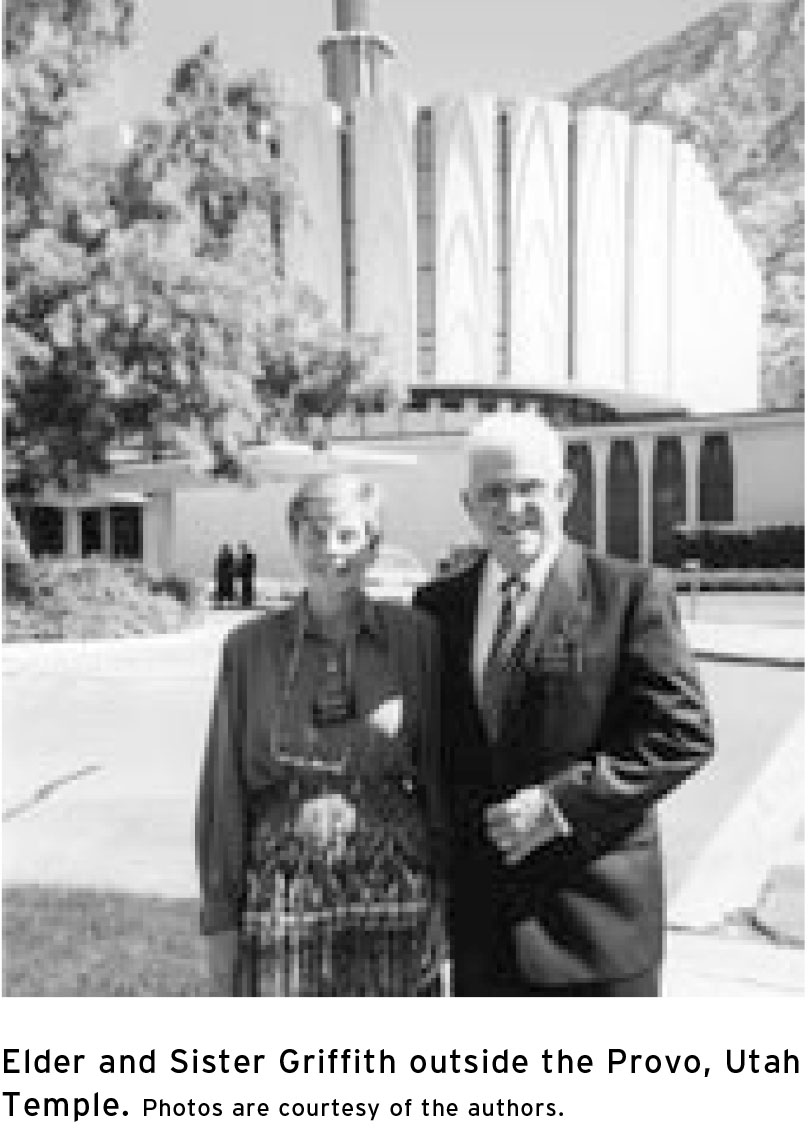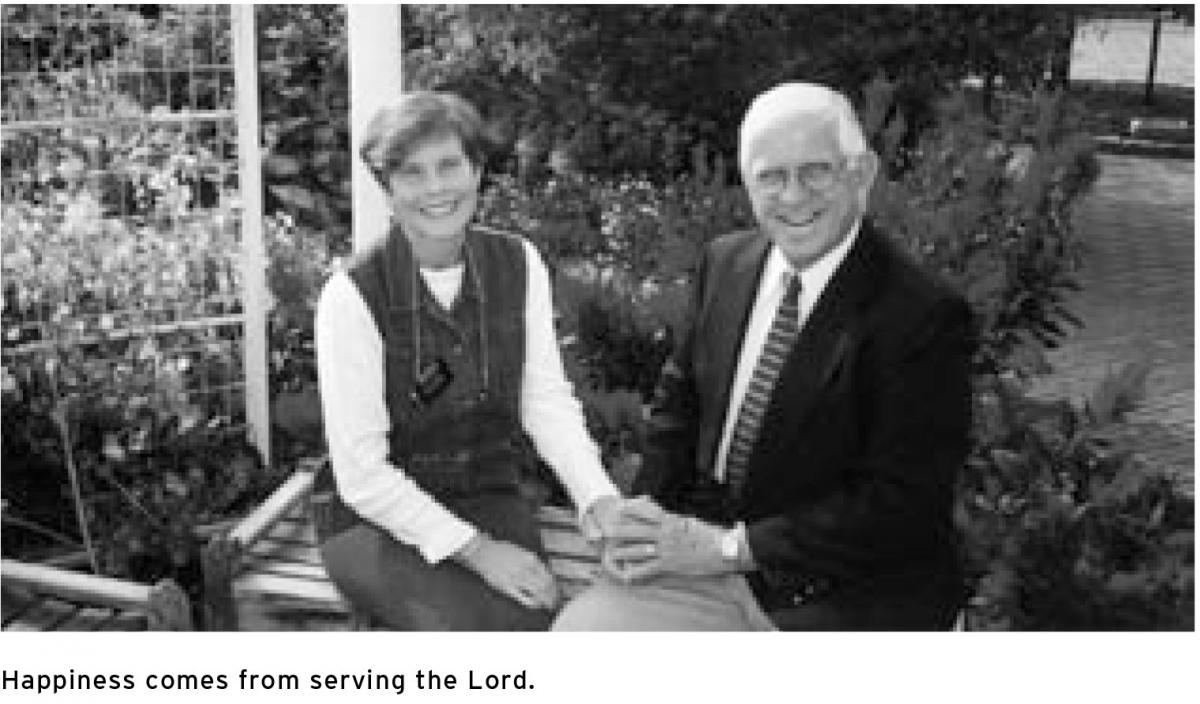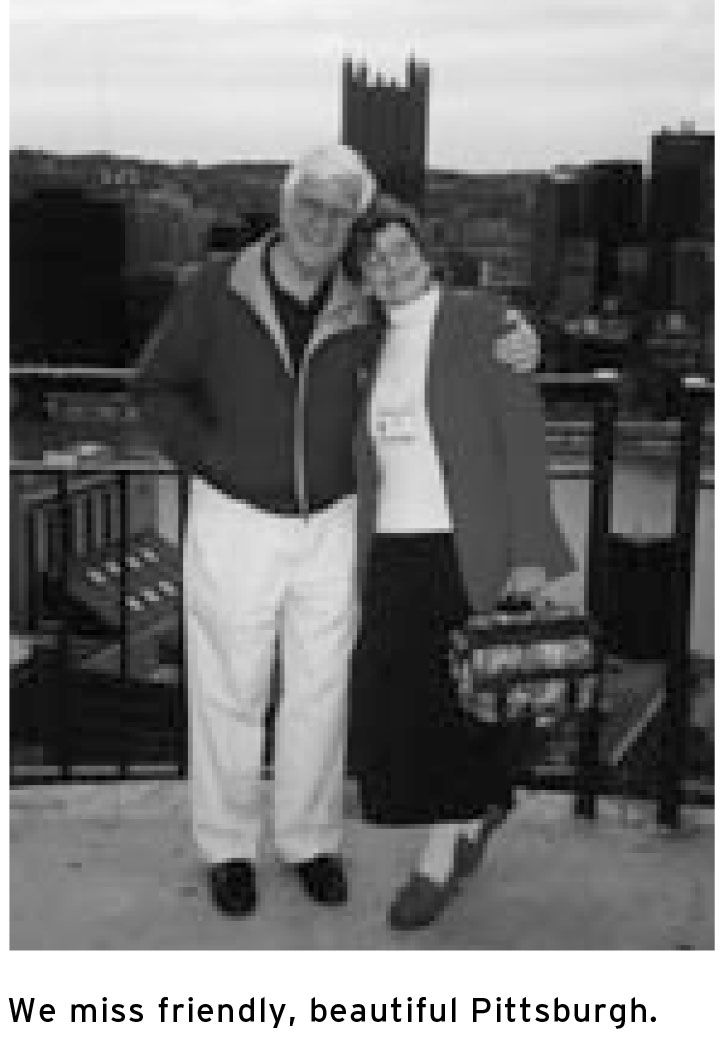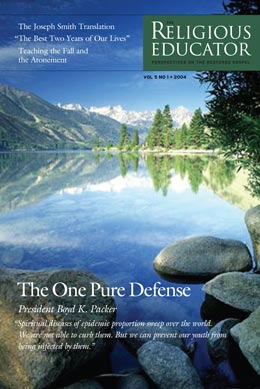“The Best Two Years of Our Lives”: A CES Mission Remembered Ed and Bunkie Griffith
Ed Griffith and Bunkie Griffith
Ed and Bunkie Griffith, “‘The Best Two Years of Our Lives’: A CES Mission Remembered,” Religious Educator 5, no. 2 (2004): 75–82.
Ed and Bunkie Griffith had returned recently from a twenty-three-month Church Educational System mission in Pittsburgh, Pennsylvania when this was published.
Sister Griffith has written a portion of their story, detailing some of the trials and some of the successes. The hope in publishing this article is that the Griffiths’ experience and example might act as a motivation, comfort, and source of excitement to those considering a similar course.
My husband and I had always known we would go on a mission when my mother passed away. We did not know she would live to be ninety-six, but when she died suddenly, in excellent health, we knew it was time for us to go. The day after her death, even before her funeral, we submitted our papers. Then we waited and waited. We had said we would go anywhere, for any length of time, on any kind of mission.
Four months later, we received our call to serve a twenty-three-month CES mission in Pittsburgh, Pennsylvania, and three weeks later we were on our way to the Missionary Training Center for six days. (When I asked my husband, Eddy, to help me remember how many days we were there, he answered, “Forty-eight years.”)
We packed our SUV (the truck that would later become the mission “limo”) with everything we thought we would need for the next two years and started on a four-day, cross-country drive that would give us plenty of time to wonder what awaited us in Pennsylvania. We couldn’t believe our eyes when we rounded a curve at twilight and suddenly saw the incredible Pittsburgh skyline. It was the beginning of a love affair with the city of Pittsburgh and its friendly people, especially the young adults and missionaries whom we would make our focus for the fastest twenty-three months of our lives.
Getting Situated
After we scoured the want ads and called about every apartment that looked like it might fulfill our needs, my husband drove us to look at ten apartments. Because neither of us had ever been to Pittsburgh before, this in itself was quite a feat. The only available apartments were the ones that the students at the University of Pittsburgh and Carnegie Mellon University had rejected.
Our wants, we thought, were small: we wanted a place with a garage our 6-foot-8-inch-tall seven-passenger truck would fit in, and we wanted to be within walking distance of the church. As recent transfers from southern California, we were trying to protect ourselves from the cold winters we feared. (The winters turned out to be mild; it was the humidity in July that we weren’t prepared for.)
We moved into the tenth apartment we looked at. It was void of furniture except for our air bed, which we had carried with us on top of the truck. Our next stop was IKEA to buy furniture, although IKEA’s advertisement, “some furniture may need assembling,” turned out to be quite an understatement. Every piece of furniture we bought for our new home needed assembling, the most difficult being two desks, which were an absolute must for us. Eddy became an expert “furniture maker,” and it was fun having all our furniture coordinated for the first time in our forty-year marriage. While he assembled, I unpacked the twenty-six boxes we had brought with us—mostly books and notebooks from my nine years of teaching Cambodian and early-morning seminary.
Getting to Work
The Oakland chapel was only seven blocks away from our Shady- side apartment, but where was the institute? To our amazement, the money had been allotted, the plans had been drawn, and the contract had been let twelve months before, but there was no construction and no institute. The

construction holdup was over where to put the $9,000 folding partition that would divide the large multipurpose room into two teaching areas. Now I knew why we had been called to Pittsburgh. My husband had been a general contractor in Albuquerque thirty-three years before we moved to California, where we were converted to the church. His solution was to leave the divider out entirely, and this turned out to be inspired. Two months later we had our 120-by-180-foot institute room, complete with a kitchen, two offices, two bathrooms, and tables and chairs for eighty people.
We had been teaching Sunday School in both the singles ward and the Pittsburgh family ward while we waited for the institute building to be finished. I taught family history, and Eddy taught mission preparation. We taught temple marriage and family relations together, alternating with Mary Eror, the best teacher of this subject I have ever heard. It was a challenge to try to keep up with her.
With the institute building finished, we were ready to really teach, or so we thought. Our CES coordinator, Chad Bailey, had said we could teach whatever we wanted, whenever we wanted. I chose “Isaiah—The Latter Days.” Because there was no manual for this, I was asked to submit to Church Education in Salt Lake City a list of all the books I wanted to use to write my own lessons. I was given permission to use all but one of the thirteen books I requested. These books provided more than enough background for getting into the scriptures and into my favorite subject.
I spent twenty hours organizing my first lesson. What a spiritual treat this was! I don’t know which I enjoyed more—preparing my lessons or giving them. I learned so much from both. I had never taught young adults before, except sisters in Relief Society and members of my ward Gospel Doctrine class, but those were different. I was scared to death; I knew the Lord had always been with me before; and I knew that teaching was certainly something I enjoyed doing. I had been an elementary school teacher for six years, three of them as a substitute, and I knew that the older the kids were, the bigger the challenge but also the greater the fun.
My first Isaiah class brought four students out on a cold Tuesday night. This number eased my fear, but it was quickly replaced by self-doubt. No one wanted to hear me teach about Isaiah. I thought everyone wanted to hear about the last days!
We had learned at the Senior MTC that when we teach the scriptures, we should teach the principles and then teach the students how to apply the principles in their lives. This worked out fantastically.
Helping Individuals
We learned that at that point in our lives, we were there to help the Savior complete His mission to bring to pass the immortality and eternal life of men and women. He had brought about the immortality of God’s children through His Atonement, but it was our job to teach and bring this understanding to as many young people as possible so they might desire to live their lives in a way that would lead them to life eternal. We felt points of success as we watched lives around us transforming.
One such transformation occurred in the life of a young man who was graduating from high school but didn’t know what to do following graduation. His girlfriend brought him to institute. He was baptized and is now serving a mission at age twenty-three, and she is happily waiting for him to return.
Another young convert didn’t know if she should marry or go on a mission that she had been eagerly planning since her baptism a year before. She talked of nothing else. At institute, she learned that if she would pray for wisdom, God would bless her with knowledge. She was married in the Washington (DC) Temple to the returned missionary she had corresponded with while he was on his mission but had not met until he got home.
One man we all learned to love had fallen from a sixth-floor scaffold and had been told in the hospital that he would never walk again. The elders, sent by his sister, had given him a blessing, and he had been healed immediately. Many years later, our sister missionaries were inspired to talk to him at a bus stop. He knew at once that the Lord had sent them to him. He took the missionary discussions and came to institute for every class. We never saw anyone so hungry for the gospel.He has been baptized and is a now a very strong member. His teenage son, who had been going down a very dangerous path, has also joined the Church.
One brilliant young man was actively fighting against the Church and its principles. He came to institute and the Missionary Preparation class, where he met his future wife. He soon became a dedicated member of the Church and did a great job with our e-mail list, one of the most demanding callings in the singles ward. He and his wife were married in the Columbus Ohio Temple, and they both still faithfully attend institute classes.
The experiences we had could never be bought with money. They helped us understand why we are on this earth and the joy that is found in helping bring the promise of eternal life to others.

Finding Our Purpose
Eddy and I determined that we needed to get more university students coming to institute. Maybe students working on master’s and doctoral degrees would be more in tune with Isaiah. Most of the Oakland Singles Ward was composed of young adults who had grown up in Pittsburgh and were working locally. However, our building was nestled in the midst of nine universities and colleges. Besides the University of Pittsburgh and Carnegie Mellon University, we had Duquesne University, Carlow College, two chef schools, Chatham College, Robert Morris University, Pittsburgh Art Institute, and Community College of Allegheny County.
How could we reach these students? We decided that we first had to reach the twenty-three bishops and branch presidents who made up the two Pittsburgh stakes. We invited them, their wives, and the members of the stake presidencies and their wives to see the new institute and enjoy a New Mexico barbeque—without having to bring a thing. The wives enjoyed this, and the husbands enjoyed meeting one another. Many had never met before. This surprised us, but most of the chapels housed only one ward, and there was very little social contact among wards, let alone between the two stakes.
I had lots of experience planning and cooking for groups as the wife of a bishop and stake president and also as a counselor in the stake Relief Society and a Relief Society president, but I had never cooked for sixty-four people all by myself. Our seminary teacher and institute secretary, Valerie Jeffreys, insisted on bringing dessert: she wouldn’t take no for an answer. But I could not let anyone else contribute; it had to be that way, because we had a favor to ask in return.
We wanted to get all these people excited about institute, and we needed their cooperation in getting the names of the young adults in their wards and branches. This plan worked beautifully. My husband called the eight hundred phone numbers we received, asking only for e-mail addresses. He didn’t put anyone on the spot. He discovered that young adults move from apartment to apartment as often as the weather changes and that they change their phone numbers as often as they change roommates, but they rarely change their e-mail addresses. We found that getting less-active members to look at an LDS Web site was impossible, but they checked their e-mail almost every day. This was something they wanted to do. After Eddy established an institute and singles ward e-mail list, an e-mail specialist was called from the ward. This person sent out weekly invitations to our classes and social events and made changes to our always-expanding list. We kept the list updated by having everyone who attended a function at the institute sign the roll with his or her name and e-mail address.
Full-time institute employees keep the same school-year schedule as their students, but since we had students from nine schools plus locals home for the summer, we were given permission by Barry Norton, our new institute coordinator, to teach institute year-round. This worked out well. This meant we had institute classes all summer, at Christmastime, and during all the different spring breaks. Fifty-two weeks a year, the Pittsburgh Institute of Religion was open.
We also tried teaching on Saturday nights and at other locations, but the students preferred driving two and a half hours from West Virginia, New York, or Ohio to missing out on meeting a new prospect or an old friend at our combined Friday night institute and social.
Working with Other Missionaries
A totally different aspect of our calling was working with the elders and sister missionaries and with President Scott Cameron and Sister Chris Cameron. Our Pittsburgh mission president and his wife were very gracious to us. They invited us to all the mission conferences for their 160 missionaries. They even allowed us, with the assistants, to plan and put on two of the conferences. Eddy was asked to bear his testimony at every conference. Being there allowed us to see again the missionaries who had transferred from our zone. This was such a blessing because we missed them so much.
A spiritual highlight of our association with these elders and sisters was our Tacos and Testimonies meetings at our apartment. A night or so before transfer announcements, we invited the missionaries who were going home and their companions to our apartment for all-you-can-eat tacos, followed by practice for their upcoming meetings with their stake presidents and high council. This was an experience they were all dreading. Eddy explained to them what they would be expected to do and what questions they would probably be asked. Then they practiced. They included spiritual experiences most of us had never heard about and their testimonies like we had never before heard them given. Many tears were shed. Many feelings were experienced that had not been felt quite like that before.
A special time for me was our Christmas mission conferences, when we got to be with all the missionaries at a tearful time in their missions. I was asked to put on the Christmas program the first year and was told to try to make it upbeat without losing sight of its real meaning. My first thought was The Best Christmas Pageant Ever, by Barbara Robinson. My second thought was how funny it was, but I still felt strongly about it, so I approached Sister Cameron with the idea. Her immediate response was, “That’s my husband’s favorite Christmas story; we read it every year!” So with her enthusiastic approval, I put on my director-actor’s hat, but especially my editor’s cap. It took me fifty times through the book to get it down from sixty-plus minutes to twenty-five. It was the perfect touch, not just the laughter the Herdman family invoked but also the feelings this family had while experiencing Christmas for the very first time. This was truly the reason Jesus came for all of us.
For Christmas 2002, I was put in charge of Christmas dinner for ninety missionaries, and Eddy and I decided to do it alone, another first for me. I also brought back the Herdmans by unanimous request of the elders and sisters who had been there the year before.
We had three different mission presidents in our two years. Our first mission president’s wife, Chris, is a nurse, but when they were called home for medical reasons, I was asked to handle mission medical needs for the two following presidents. This was surprisingly easy; all I had to do was take phone calls from any missionaries with medical problems and then call Dr. Cordon, our regional mission doctor and a senior missionary. He was fabulous. I never had to call him twice, plus he always called me back to keep me informed. I loved getting to know the missionaries. This was a little like being a mom again. And when the missionaries felt better, even though I didn’t do a thing, they thought I was wonderful.
Conclusion
The time we spent as Church Educational System missionaries really was the happiest two years of our lives because we were on Heavenly Father’s errand all the time. We were spared knowing the problems at home that we didn’t really need to know about. We didn’t worry about our three children or their children; we prayed for them always; and we knew Heavenly Father loved them even more and knew their needs even better than we did. So we focused on the work. Eddy and I were on the same wavelength. If we happened to be apart for a couple of hours, we missed each other.

Coming home has been very difficult. We miss our young adult Saints tremendously; we miss the Holy Ghost’s constant inspiration; and we miss friendly, beautiful Pittsburgh. We miss Heavenly Father’s constant care. His concern is still constant, but now we realize how much He sheltered us physically, mentally, emotionally, and environmentally. The joy showered upon us daily was a blessing and a gift. We never felt we earned it.
We felt God’s presence in all we were doing, and we knew what we were doing was what our Heavenly Father wanted us to do—and that was always peaceful and rewarding. That was something we needed at that time in our lives—something we had never known before.
Back home, we have our trials we must endure so we can continue to grow. In Pittsburgh, the Lord gave us experiences, not trials, that we might continually give and serve and experience joy. As we taught and served our mission, we came to know the Savior so much better than we ever had before. It is a marvelous experience to be in the service of the Lord twenty-four hours a day, seven days a week. As we studied and served, we learned of the love the Son has for His Father. We understood how the Savior taught. We learned how He suffered for us and was resurrected so that we may all return to Him. We felt closer to the Savior than we had ever felt in our lives. What a wonderful way to spend our senior years!
